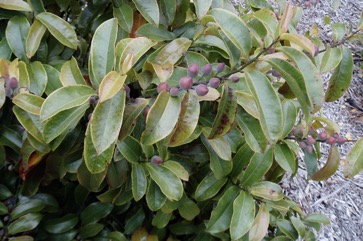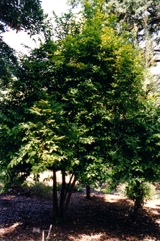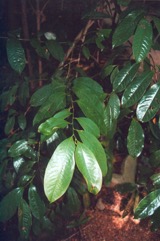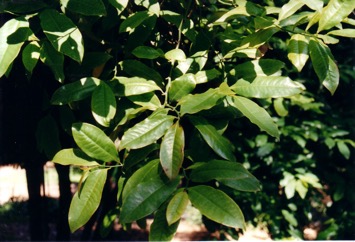Bolwarra, Copper Laurel, Native Guava

A tropical and subtropical plant. It does best in rich moist soils. It suits a protected sunny position. It is damaged by drought and frost. It grows in the lowland rainforest. It can grow in full sun or shade. In Papua New Guinea is grows from sea level to 1250 m altitude. It needs well drained soil. It is often along creek banks. In the Cairns Botanical Gardens. It can grow in cooler places and tolerate light frosts. Melbourne Botanical gardens. Mt Cootha Botanical Gardens.
Also known as:
Soli
Edible Portion
- Fruit
Where does Bolwarra grow?
Found in: Australia, Pacific, Papua New Guinea, PNG
Notes: There are 2 Eupomatia species.
Growing Bolwarra, Copper Laurel, Native Guava
Cultivation: It can be grown from seed or cuttings. The flesh is removed and the seed sown fresh. Seed can be slow to germinate. It can take 1-6 months to germinate. A temperature above 25°C is probably necessary. Flowers are pollinated by beetles.
Edible Uses: The ripe fruit are eaten raw. The fruit become almost black when fully ripe and then fall. The juice from the fruit can be used for ice cream or yogurt. The seeds are bitter and should be avoided.
Production: Plants flower from November to March and fruit from January to June. The fruit fall to the ground when ripe.
Nutrition Info
per 100g edible portion| Edible Part | Energy (kcal) | Protein (g) | Iron (mg) | Vitamin A (ug) | Vitamin c (mg) | Zinc (mg) | % Water |
|---|---|---|---|---|---|---|---|
| Fruit | 83 | 1 | 1.1 | - | 1 | 1.1 | 82.1 |
Bolwarra, Copper Laurel, Native Guava Photos




References
Beasley, J., 2011, Plants of Tropical North Queensland - the compact guide. Footloose publications. p 132
Bodkin, F., 1991, Encyclopedia Botanica. Cornstalk publishing, p 465
Caton, J.M. & Hardwick, R. J., 2016, Field Guide to Useful Native Plants from Temperate Australia. Harbour Publishing House. p 196
Cherikoff V. & Isaacs, J., The Bush Food Handbook. How to gather, grow, process and cook Australian Wild Foods. Ti Tree Press, Australia p 154, 195, 200
Cooper W & Cooper W T, 1994, Fruits of the Rain Forest. RD Press p 124 (Picture)
Cooper, W. and Cooper, W., 2004, Fruits of the Australian Tropical Rainforest. Nokomis Editions, Victoria, Australia. p 199
Cribb, A.B. & J.W., 1976, Wild Food in Australia, Fontana. p 33
Croft, J.R., in Womersley, J.S., (ed), 1978, Handbooks of the Flora of Papua New Guinea. Melbourne University Press,Victoria. Vol 1, p 123 (Drawing)
Cronin, L., 1989, The Concise Australian Flora. Reed. p 139
Elliot, W.R., & Jones, D.L., 1992, Encyclopedia of Australian Plants suitable for cultivation. Vol 4. Lothian. p 260
Facciola, S., 1998, Cornucopia 2: a Source Book of Edible Plants. Kampong Publications, p 101
M. Flinders, Voy. Terra austr. 2:597, t. 2. 1814
Hardwick, R.J., 2000, Nature's Larder. A Field Guide to the Native Food Plants of the NSW South Coast. Homosapien Books. p 108
Haslam, S., 2004, Noosa's Native Plants. Noosa Integrated Catchment Assn. Inc. p 292
Heywood, V.H., Brummitt, R.K., Culham, A., and Seberg, O. 2007, Flowering Plant Families of the World. Royal Botanical Gardens, Kew. p 147
Hiddins, L., 1999, Explore Wild Australia with the Bush Tucker Man. Penguin Books/ABC Books. p131
Hibbert, M., 2002, The Aussie Plant Finder 2002, Florilegium. p 100
Hide, R. L., (Ed.) 1984, Research Report of the Simbu Land Use Project. Vol.V1 South Simbu: Studies in Demography, Nutrition, and Subsistence. p 434
Jackes, B.R., 2001, Plants of the Tropics. Rainforest to Heath. An Identification Guide. James Cook University. p 54
Jones D, L, 1986, Ornamental Rainforest Plants in Australia, Reed Books, p 217, 340
Johns, R.J., 1976, Common Forest Trees of Papua New Guinea. Part 2 Angiospermae, Forestry College Bulolo, PNG p 38
Lord, E.E., & Willis, J.H., 1999, Shrubs and Trees for Australian gardens. Lothian. p 15
Low, T., 1991, Wild Food Plants of Australia. Australian Nature FieldGuide, Angus & Robertson. p 71
Molyneux, B. and Forrester, S., 1997, The Austraflora A-Z of Australian Plants. Reed. p 95
Morley, B.D., & Toelken, H.R., (Eds), 1983, Flowering Plants in Australia. Rigby. p 34
Nicholson, N & H., 1996, Australian Rainforest Plants 2, Terania Rainforest Publishing. NSW. p 28
Ratcliffe D & P., 1987, Australian Native Plants for Indoors. Little Hills press. p 88
Recher, P, 2001, Fruit Spirit Botanical Gardens Plant Index. www.nrg.com.au/~recher/ seedlist.html p 6
Yallakool Reserve Plant List July 1, 2009 Off internet
Young, P.A.R., 1991, Rainforest Guide. Brisbane Forest Park. p 30
World Checklist of Useful Plant Species 2020. Royal Botanic Gardens, Kew
www.ceres.org.au/bushfoodcatalogue